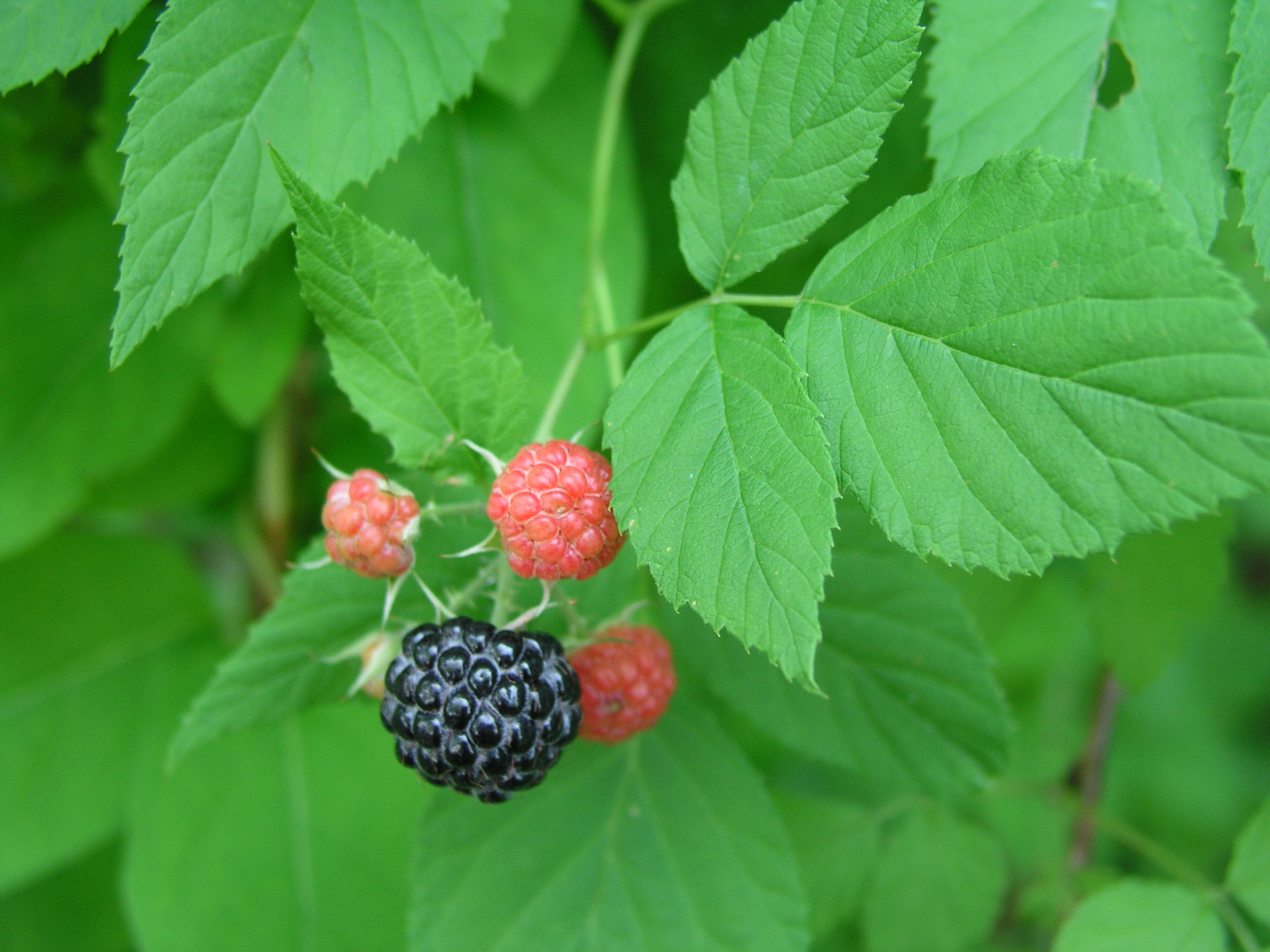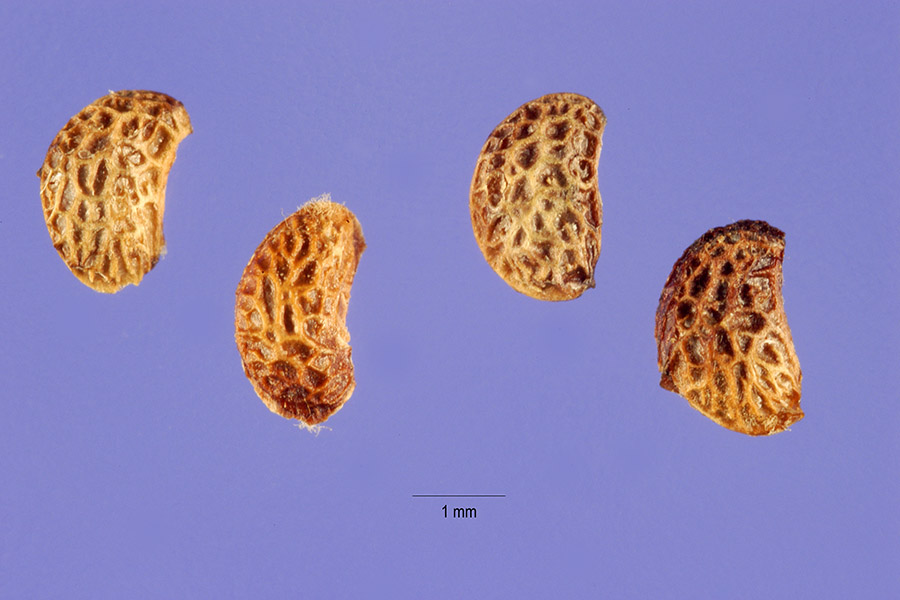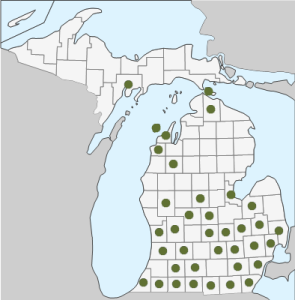 Download PDF
Download PDF
Name: Rubus occidentalis L.
Family: Rosaceae (the Rose family)
Common Names: Black Raspberry, Black-cap (8), Thimbleberry (4), framboise noire, scotch-cap, purple raspberry, black-berry (21, 22).
 Etymology: Rubus is Latin for “bramble,” “blackberry,” or “raspberry.” Occidentalis is Latin for “western” or “of the west” (2, 13).
Etymology: Rubus is Latin for “bramble,” “blackberry,” or “raspberry.” Occidentalis is Latin for “western” or “of the west” (2, 13).
Botanical synonyms: None found
Quick Notable Features:
¬ Leaves palmately compound, 3-5 leaflets that are white and pubescent underneath
¬ Terminal leaflet is larger than the lateral leaflets
¬ Petals are about half as long as the sepals.
¬Arching, glaucous purple stems, armed with prickles
Plant Height: The erect shrubby climber can be up to 2m tall with 1-2m long branches (9).
Subspecies/varieties recognized (16, 20):
Rubus occidentalis var. eriocarpus Focke
Rubus occidentalis L. var. flavobaccus Blanch.
Rubus occidentalis L. var. grandiflora Focke
Rubus occidentalis L. var. incisus Schltdl.
Rubus occidentalis var. japonicus Miyabe
Rubus occidentalis var. leucodermis (Douglas ex Torr. & A. Gray) Focke
Rubus occidentalis L. var. mexicanus Focke
Rubus occidentalis var. occidentalis
Rubus occidentalis L. var. pallidus L.H. Bailey
Rubus occidentalis L. f. pallidus B.L. Rob.
Most Likely Confused with: A hybrid of itself and Rubus strigosus, sometimes called Rubus neglectus, as well as Rubus strigosus and other members of the genus Rubus, such as R. alleghaniensis. It also may be confused with Rosa multiflora.
Habitat Preference: Prefers open, undisturbed habitats such as fields, thickets, clearings, ravine flats, along hillsides, and in open woods. It lives in both dry and moist areas, along roadsides, rocky sites, and fence rows (5, 6, 7, 9, 10, 12).
Geographic Distribution in Michigan: This species lives in 35 counties of the lower peninsula, most of which are in the southern half, and only Delta county in the upper peninsula (9, 23).
Known Elevational Distribution: It has been noted in the Great Smoky Mountains National Park to grow only below 610m (11).
Complete Geographic Distribution: Native to every state east of and including Colorado, except for Texas, Louisiana, and Florida. In Canada, it can be found in Quebec, Ontario, and New Brunswick (15).
 Vegetative Plant Description: Leaves are palmately compound with 3-5 leaflets per leaf and deciduous, setaceous stipules. The leaflets are green and glabrous above, and white tomentose beneath. They are 5-9cm long and 3-7cm wide (7, 22). Leaflets are ovate with a rounded base and a tapered apex, with sharp, jagged serrations along the whole margin of the leaflet, except the base. The terminal leaflet is usually larger than the other leaflets, but has the same morphology (5). The whitened stems can be erect or ascending, some arch and root at the tips. The white portion of the stem is easily rubbed off, revealing a purple color below, as in the older stems (9). The stem is without glands and bears a few spines, some hooked and others straight always narrowing at the tip. The petioles and the pedicels bear spines as well. The flowerless, first-year shoot, has dense, white glaucous stems and usually contains 3, but sometimes 5, leaflets per leaf. The flowering and fruit-bearing, second-year shoot is glabrous and contains 3 leaflets per leaf (3, 4, 6, 7, 9, 12).
Vegetative Plant Description: Leaves are palmately compound with 3-5 leaflets per leaf and deciduous, setaceous stipules. The leaflets are green and glabrous above, and white tomentose beneath. They are 5-9cm long and 3-7cm wide (7, 22). Leaflets are ovate with a rounded base and a tapered apex, with sharp, jagged serrations along the whole margin of the leaflet, except the base. The terminal leaflet is usually larger than the other leaflets, but has the same morphology (5). The whitened stems can be erect or ascending, some arch and root at the tips. The white portion of the stem is easily rubbed off, revealing a purple color below, as in the older stems (9). The stem is without glands and bears a few spines, some hooked and others straight always narrowing at the tip. The petioles and the pedicels bear spines as well. The flowerless, first-year shoot, has dense, white glaucous stems and usually contains 3, but sometimes 5, leaflets per leaf. The flowering and fruit-bearing, second-year shoot is glabrous and contains 3 leaflets per leaf (3, 4, 6, 7, 9, 12).
Climbing Mechanism: Uses its spiny stem to attach itself to other plants (Robyn J. Burnham, pers. obs.).
 Flower Description: 3-7 perfect flowers are contained in a dense umbellate to corymbose and mostly terminal inflorescence. The calyx has 5 tomentose sepals that taper to a point and are 6-8mm in length. The white petals are narrow, obovate and are 3-4.5mm in length. The flower has many erect stamens with small yellow anthers. The stigma has 2-3 lobes and the ovaries are green (3, 5, 7, 9, 12).
Flower Description: 3-7 perfect flowers are contained in a dense umbellate to corymbose and mostly terminal inflorescence. The calyx has 5 tomentose sepals that taper to a point and are 6-8mm in length. The white petals are narrow, obovate and are 3-4.5mm in length. The flower has many erect stamens with small yellow anthers. The stigma has 2-3 lobes and the ovaries are green (3, 5, 7, 9, 12).
Flowering Time: The species flowers between April and July in North America (1), and flowers between May and June in Michigan (9).
Pollinator: Nothing found in the literature for R. occidentalis. Bumblebees pollinate plants of the genus Rubus (18) and many species can self-pollinate.
Fruit Type and Description: The fruit is an “aggregate of drupes” (9), purplish-black when ripe, which is usually between June and August in North America. The aggregate is 12-15mm in diameter with white tomentum between the drupelets. When ripe, the fruit separates easily from the receptacle as a whole (1, 4, 7, 8, 9).
 Seed Description: Seeds are tan in color with an irregular shape and rough texture. They are ca. 2.4mm long (3). 740 seeds weigh one gram (1).
Seed Description: Seeds are tan in color with an irregular shape and rough texture. They are ca. 2.4mm long (3). 740 seeds weigh one gram (1).
Dispersal Syndrome: Songbirds, game birds, and mammals all eat the fruit seeds, suggesting seed dispersal is by animals (3).
Distinguished by: The petioles and inflorescence of Rubus neglectus are mostly glandular, while the inflorescence of Rubus occidentalis is tomentose. The inflorescence is also “more compact” in R. neglectus than in R. occidentalis (6,9). Rubus strigosus has pedicels that are glandular and bears a red mature fruit, while R. occidentalis has pedicels without glands and a purplish-black mature fruit (10). Rubus alleghaniensis has leaves that are green on both sides while occidentalis has white undersides to its leaves (9). Rosa multiflora bears stipules on the petiole and has an achene ripening in a rosehip that is red when ripe. Rubus occidentalis does not bear stipules and its fruit is a aggregate of drupes (10).
Other members of the family in Michigan (number species): Rubus (48), Agrimony (5), Amelanchier (6), Argentina (1), Aruncus (1), Chamaerhodos (1), Comarum (1), Crataegus (42), Dalibarda (1), Dasiphorda (1), Duchesnea (1), Filipendula (1), Fragaria (2), Geum (9), Gillenia (2), Malus (4), Photinia (2), Physocarpus (2), Potentilla (11), Prunus (16), Pyrus (1), Rosa (18), Sanguisorba (3), Sibbaldiopsis (1), Sorbaria (1), Sorbus (3), Spiraea (6), Waldsteinia (1) (source 15).
Ethnobotanical Uses: The berries are used in jams and pies (3). The leaves can be used to make a tea and a second kind of tea can be made from the root’s bark. Medicinal uses of the roots include treatment of cough and toothache (14).
 Phylogenetic Information: The genus Rubus is a member of the subfamily Rosoideae in the family Rosaceae. Rosoideae is distinguished by having many carpels and an aggregate of achenes or drupes as fruit (19). Rosaceae fossils date to 76 million years. The Rosaceae is placed within the order Rosales, which has been dated to 89 million years. Rosales is in the subclass Rosidae, which is a member of the eudicots (17).
Phylogenetic Information: The genus Rubus is a member of the subfamily Rosoideae in the family Rosaceae. Rosoideae is distinguished by having many carpels and an aggregate of achenes or drupes as fruit (19). Rosaceae fossils date to 76 million years. The Rosaceae is placed within the order Rosales, which has been dated to 89 million years. Rosales is in the subclass Rosidae, which is a member of the eudicots (17).
Interesting Quotation or Other Interesting Factoid not inserted above: Rubus occidentalis was thought in the 1960’s to be a good plant for conservation of certain mammals and birds. It provides a food source and any dense patches help to conceal them (3).
Literature and websites used:
- Young, J.A. and C.G. Young. 1992. Seeds of Woody Plants in North America. Portland, Oregon, USA: Dioscorides Press.
- Bailey, H.L. 1963. How Plants Get Their Names. New York, New York, USA: Dover Publications, Inc.
- Stephens, H.A. 1969. Trees, Shrubs, and Woody Vines in Kansas. Lawrence, Kansas, USA: The Regents Press of Kansas.
- Parkhurst, H.E. 1903. Trees, Shrubs and Vines of the Northeastern United States. New York, New York, USA: C. Scribner’s Sons.
- Gleason, H.A. 1963. The New Britton and Brown Illustrated Flora of the Northeastern United States and Adjacent Canada. New York, New York, USA: Hafner Publishing Co., Inc.
- Braun, E. Lucy. 1967. The Woody Plants of Ohio: Trees, shrubs, and woody climbers, native, naturalized, and escaped. Columbus, Ohio, USA; The Ohio State University Press.
- McGregor R.L. 1986. Flora of the Great Plains. Lawrence, Kansas, USA: The University Press of Kansas.
- Gleason, H.A. and A. Cronquist. 1991. Manual of Vascular Plants of the Northeastern United States and Adjacent Canada. Bronx, New York, USA: New York Botanical Garden Press.
- Barnes, B.V. and W.H. Wagner Jr. 1981. Michigan Trees: A Guide to the Trees of Michigan and the Great Lakes Region. Ann Arbor, Michigan, USA: The University of Michigan Press.
- Voss, E. G. 1985. Michigan Flora Part II: Dicots. Ann Arbor, Michigan, USA: Cranbrook Institute of Science.
- Stupka, A. 1964. Trees, Shrubs, and Woody Vines of Great Smoky Mountains National Park. Knoxville, Tennessee, USA: The University of Tennessee Press.
- Radford, A.E., H.E. Ahles, and C.R. Bell. 1968. Manual of the Vascular Flora of the Carolinas. Chapel Hill, North Carolina, USA: The University of North Carolina Press.
- Brown, R. W. 1956. Composition of Scientific Words. Washington, D.C., USA: Smithsonian Institution Press.
- Plants For A Future, 1996-2008. http://www.pfaf.org/database/plants.php?Rubus+occidentalis.
- USDA, NRCS. 2008. The PLANTS Database.http://plants.usda.gov/java/profile?symbol=RUOC (Nov. 5th 2008).
- The International Plant Names Index. http://www.ipni.org/index.html
- Stevens, P.F. Angiosperm Phylogeny Website. Version 9 June 2008. http://www.mobot.org/mobot/research/apweb.
- Heidenreich, C., M. Pritts, M.J. Kelly, and K. Demchak. 2008. Department of Horticulture Publication No. 47. www.fruit.cornell.edu/Berries/bramblepdf/hightunnelsrasp.pdf
- Zomlefer, W.B. 1994. Guide to Flowering Plant Families. Chapel Hill, North Carolina, USA: The University of North Carolina.
- Tropicos.org. Missouri Botanical Garden. 04 Jan 2013 http://www.tropicos.org/Name/27801319
- Fernald, M. L. 1950. Gray’s Manual of Botany, 8th ed. New York: American Book Company.
- Britton, N.L. & H.A. Brown 1970. An Illustrated Flora of the Northern United States and Canada: Volume I. New York, NY: Dover Publications, Inc.
- MICHIGAN FLORA ONLINE. A. A. Reznicek, E. G. Voss, & B. S. Walters. February 2011. University of Michigan. January 4, 2013. http://michiganflora.net/species.aspx?id=2559.
Image Credits (all used with permission):
1) Image of the leaves with white abaxial surfaces is copyright Robyn J. Burnham.
2) Image of the flower is from the USDA website courtesy of Jennifer Anderson @ USRC-NRCS PLANTS database.
3) Image of fruit is courtesy of George P. Chamuris from “Hiker’s Guide to the Trees, Shrubs, and Woody Vines of Ricketts Glen State Park” http://departments.bloomu.edu/biology/Ricketts/index.html
4) Image of the seeds is from the USDA website courtesy of Steve Hurst @ USRC-NRCS PLANTS database.
5) Species distribution map, derived from the Michigan Flora Online.
Primary Authors: Dave Morris with editing from ReBecca Sonday, John Bradtke, and Robyn J. Burnham
© Robyn J. Burnham, University of Michigan
For additional information on Michigan Plant Diversity web pages please contact Robyn J. Burnham via email: rburnham“at”umich.edu